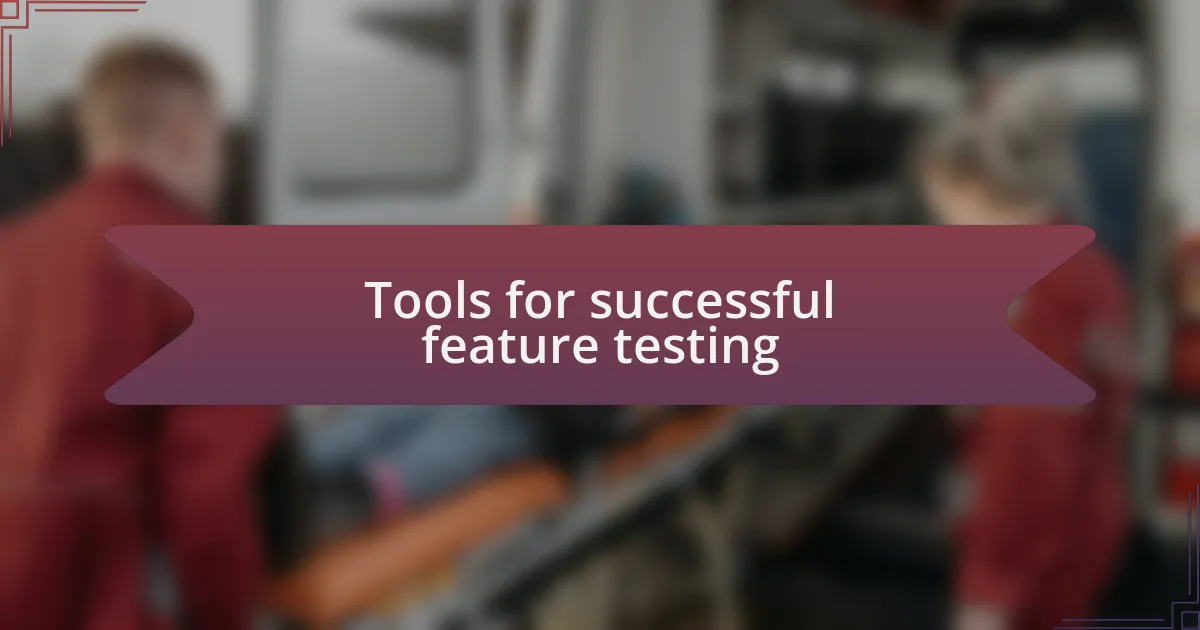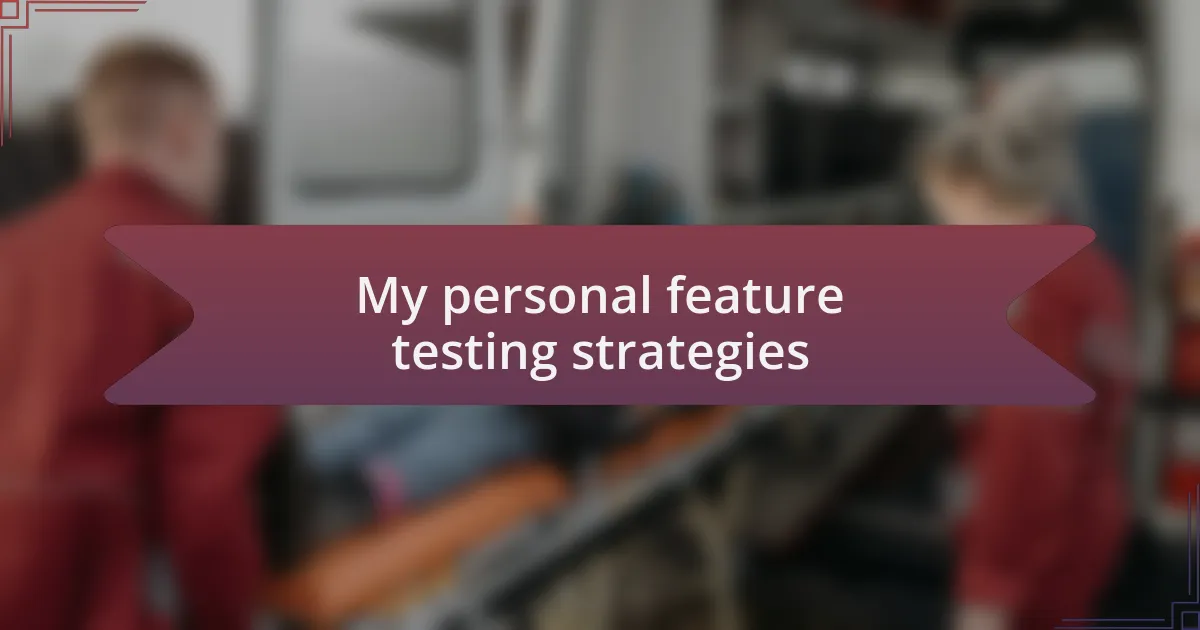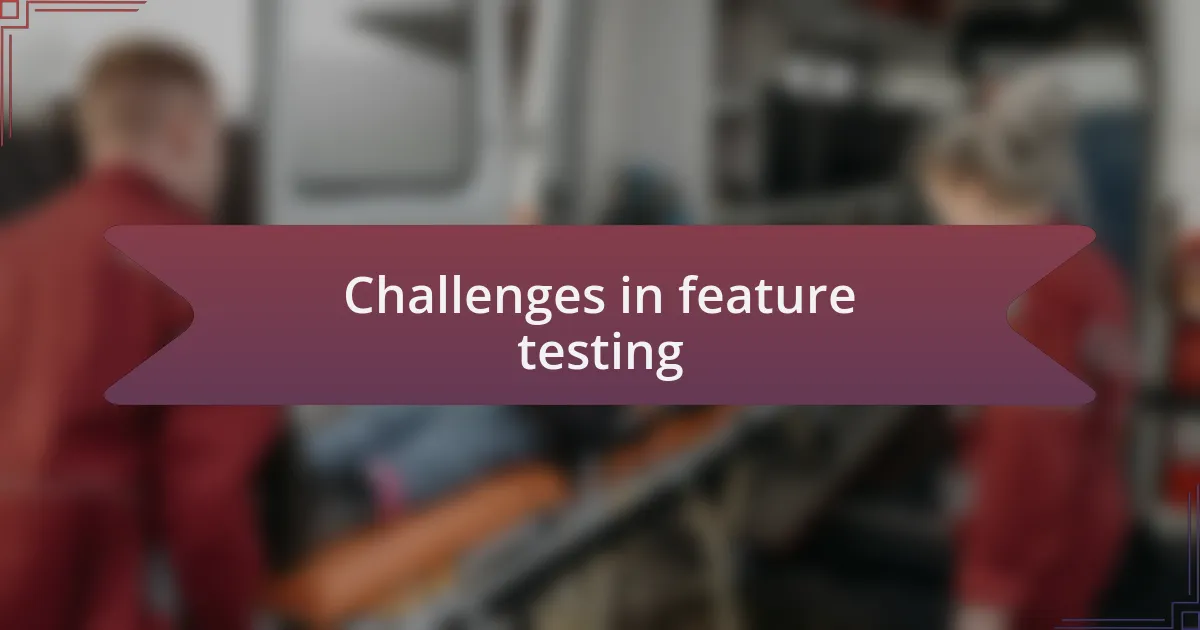Key takeaways:
- Feature testing is essential for enhancing user experience and preventing costly mistakes by understanding user needs and gathering feedback.
- Real-world testing and iterative feedback are crucial; observing users in natural settings provides valuable insights that lab environments cannot offer.
- Effective tools, such as A/B testing and automation software, streamline the testing process, improve collaboration, and enhance communication among teams.
- Challenges like scope creep, team misalignment, and time constraints can hinder effective feature testing, highlighting the need for clear goals and communication.

Understanding feature testing importance
Feature testing is crucial because it directly impacts user experience and satisfaction. I remember when I rolled out a new feature on a project, only to discover later that it disrupted the existing workflow for users. It was a humbling moment that underscored how testing can prevent costly missteps.
Without proper feature testing, you might find yourself investing time and resources into aspects that users simply find frustrating. Have you ever tried a new app only to delete it seconds after opening? Each of those bad experiences tells the developers something vital: if we want our users to love what we’ve built, we need to understand their needs through precise testing.
Feature testing also fosters a culture of continuous improvement within a team. I find that when lines of communication about features remain open through testing phases, it often leads to innovative ideas that enhance the product. Isn’t it rewarding to see how a collaborative approach can not only refine a feature but also motivate the entire team?

Key principles of feature testing
One of the key principles of feature testing is prioritizing user feedback. I recall a situation where we implemented a highly anticipated feature that, in theory, looked perfect. However, after gathering user insights, it turned out that it created confusion instead of enhancing their experience. Listening to users not only saved us from a potentially disastrous release but also helped us iterate on the feature in ways we hadn’t even considered.
Another important aspect is testing in real-world conditions. I’ve learned that simulating user interactions in controlled environments often falls short. There’s something enlightening about observing users in their natural habitats. Perhaps you’ve experienced a scenario where a feature behaved flawlessly in a lab setting but failed miserably in everyday use. Those practical insights can lead to profound improvements.
Lastly, I emphasize the importance of iterative testing. When I first started in software development, I was eager to launch features quickly, believing that rapid delivery equaled success. Yet, I’ve come to realize that taking the time to refine features through iterative cycles not only enhances quality but also builds trust with users. Continuous feedback loops allow us to adapt and evolve, ensuring that what we build resonates deeply with our audience. Have you ever thought about how this approach could transform your workflow?

Tools for successful feature testing
When it comes to feature testing, choosing the right tools can make all the difference in achieving success. For instance, I’ve found that tools like A/B testing software really help me assess user preferences effectively. I remember a time when we used such a tool to decide between two layouts for a new dashboard. The insights we gained were invaluable and led to increased user engagement, which was a rewarding experience.
Automation tools have also been game-changers in my feature testing process. I can’t tell you the number of late nights I’ve spent manually testing features for different browsers and devices. By integrating tools like Selenium, I significantly reduced my testing time and still maintained thorough coverage. Have you ever felt overwhelmed by the prospect of testing across multiple platforms? Automation not only alleviates that stress but also allows for more thorough testing, ultimately leading to a better user experience.
Finally, I believe collaboration platforms are essential for effective communication during feature testing. When I began partnering with designers and product managers, we faced hurdles with misaligned goals and visions. Utilizing tools like Trello or Jira kept us on the same page and helped us track our iterative feedback. How often have you realized that a lack of communication can stall progress? With the right tool, you can create a streamlined testing process that fosters collaboration and drives results.

My personal feature testing strategies
My approach to feature testing is deeply rooted in iterative feedback. I recall a project where we launched an early version of a feature without extensive testing. The initial user reactions were mixed, but by collecting feedback through surveys and one-on-one interviews, we were able to make rapid improvements. Isn’t it incredible how authentic user input can shape the direction of a feature? It really reinforced my belief in the power of being adaptive and responsive to user needs.
I also prioritize creating a hypothesis around each feature I test. Before diving into implementation, I ask myself, “What are we trying to solve, and how will we measure success?” For instance, during a recent testing phase for a new onboarding process, we hypothesized that simplifying the user flow would decrease drop-off rates. By applying this method, not only did we have a clear goal, but we also celebrated a significant increase in user retention. Doesn’t it feel rewarding when a well-thought-out strategy leads to tangible results?
Moreover, I find that embracing both qualitative and quantitative data gives me a fuller picture. In one instance, I combined usage metrics from Google Analytics with user interviews to debug a feature that didn’t land as expected. The quantitative data told one story, but the qualitative data revealed user frustrations that the numbers couldn’t. Have you ever experienced the disconnect between what users say they want and what they actually do? This dual approach has become a cornerstone of my testing strategy, enriching my insights and allowing for more informed decision-making.

Challenges in feature testing
Feature testing often comes with its share of challenges that can be quite daunting. I’ve encountered situations where the scope of the features being tested seemed to expand endlessly, leading to analysis paralysis. Have you ever felt overwhelmed by endless iterations? It can slow down the process significantly and create confusion about what the original goals were.
Another hurdle I’ve faced is aligning cross-functional teams on what success looks like. Once, during a feature rollout, our marketing team and product developers had different metrics for measuring effectiveness. This misalignment created friction and led to a less cohesive user experience. It was a stark reminder of how crucial clear communication is among teams. What strategies have you found helpful in bridging such gaps?
Additionally, the time constraints within which we must operate can also challenge effective feature testing. I remember one instance where we rushed an update due to looming deadlines. The result? We missed identifying some critical user pain points, which ultimately cost us in user satisfaction. How often do you prioritize speed over thoroughness? Striking that balance is essential for meaningful outcomes in testing.